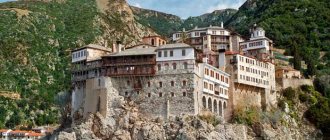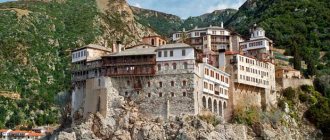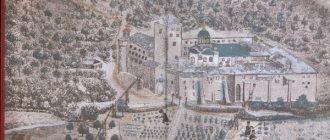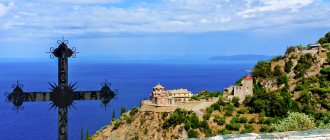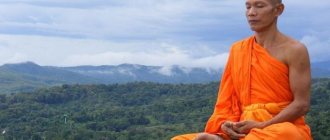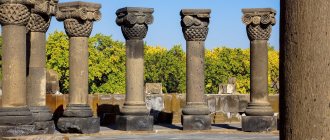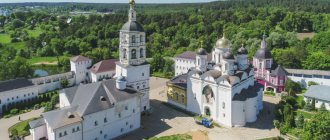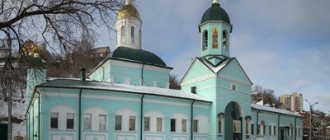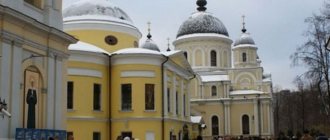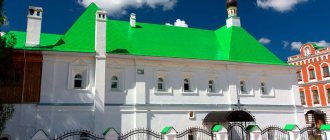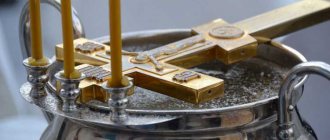If Ancient Greece left the world the greatest cultural heritage, then Greece of the 1st millennium AD is associated with religious values. Christianity spread widely throughout the country, and to this day there are a huge number of monasteries, temples, churches and chapels known throughout the world. One of the most revered monasteries is the Athos Monastery in Greece, which is visited by thousands of pilgrims every year. They all believe in the power of the Holy Lands, and in many ways Athos justifies their hopes and hopes. We will tell you about this unique Orthodox place in today’s article.
The lot of the Mother of God
The Most Holy Theotokos and the Apostle John the Theologian
Once the Most Holy Theotokos, together with Saint John the Theologian, traveled by sea, heading to Cyprus. The ship was overtaken by a storm and washed ashore. The beauty of Athos struck the Virgin Mary, and She prayerfully turned to her Son to grant Her this place as her inheritance. Since then, the whole world has known that the Holy Mountain is the inheritance and garden of the Most Holy Theotokos and the Virgin Mary.
Nature
Holy Mount Athos is a unique place. Geographically, Athos is located on the Chalkidiki peninsula in Greece. It is a peninsula jutting into the Aegean Sea and ending in the south with a 2033-meter-high mountain. It is also called Athos. The Mediterranean climate provides the Athonites with warm, rainy winters, winds in the cold season, and sultry sunny summers. Water from mountain streams is used for drinking.
Vineyards of Athos
There is very little vegetation on the southern, rocky part of the mountain. In other places, Athos abounds in vegetation: there are oak groves, spruce trees, chestnuts, plane trees, and shrubs. In high places there are moorlands. Svyatogorsk residents are engaged in growing olives, citrus fruits, walnuts, fruits and grapes.
Opening hours of the Athos Monastery and schedule of services
The Athos Monastery in Greece is open to pilgrims only during daylight hours. Visits begin at sunrise and end after sunset. When the sun has set, the gates are closed until the morning.
Divine service in the monastery:
- Vespers.
- Compline.
- Matins.
- Liturgy.
The vigil is served before the holidays and lasts all night. There is a very short break from the All-Night Vigil service to the Liturgy. Before particularly important holidays, the All-Night Vigil lasts approximately 14 hours.
Shortly before the service, the monk walks around the monastery courtyard, knocking on a wooden beater with a hammer. This is how he notifies about the imminent service, which begins in about 5-10 minutes.
History of the monastic state
The Holy Mountain became a haven for monks somewhere at the end of the 7th century. In 883, Emperor Basil the Macedonian approved in writing Athos as a place of residence only for monastics. During the Crusades, Athos came under the influence of Catholics, but the monks did not accept Uniateism.
At the beginning of the 14th century, the temples of the Holy Mountain were devastated by Catalan mercenaries, but by the end of the century there was an economic and spiritual recovery. At this time, the ideas of hesychasm - a special feat of solitude and prayer - turned out to be the most powerful.
In the 15th century, Thessaloniki was conquered by the Turks, but Athos continued to live for a long time, until the mid-16th century, without losing its rights. In 1566, Sultan Selim II took away all the lands from the Athos monasteries.
In the 7th-8th centuries, Athos became a place of enlightenment for the Greek people. At this time, the Afoniad was founded, and a printing house began operating in the Great Lavra.
In 1821, Mount Athos was occupied by the Turks, and the oppression of the Holy Mountain residents began. Thanks to the peace treaty between Turkey and Russia, liberation came in 1829 and lost property was returned.
In 1912, new unrest followed due to disagreements between Russian monasticism, which continued to submit to the Russian embassy in Constantinople, and Greek, who wanted Athos to join Greece. At this time, Russia proposed the creation of a self-governing autonomous monastic state, which was accomplished in 1924.
During World War II, the German occupation forces did not harm the property of the Holy Mountain, and did not deprive any of the monasteries of Athos of self-government.
At different times there were different numbers of inhabitants on the Holy Mountain. The smallest number of Svyatogorsk residents lived in 1971 - about a thousand people. Since that time, the number of inhabitants has been constantly growing. Now, at the beginning of the 21st century, about 1,800 monks are working on Mount Athos.
At the end of the 20th century, the Holy Mountain was included in the UNESCO World Heritage List, after which a large number of pilgrims and tourists flocked to Athos.
Interesting Facts
Legends and facts:
- After the resettlement from Nagorny Rusik, the monks took with them shrines, one of them was the icon of the Great Martyr Panteleimon. One morning they entered the temple to serve God and did not see the image on the spot. After some time, she was found in the Cathedral of Old Rusik. The icon was returned to its place of settlement. When the next day arrived, the icon returned back to the monastery abandoned by the monks. They did not understand the admonition, the icon was returned back to the coast, and it never left this place.
- A short time later, God’s permission came to the monastery in the form of a strong earthquake during Bright Week. The abandoned monastery crumbled to its foundations - fraternal cells, 2 cathedral churches painted in the 14th century with 15 small churches. The icon of St. Panteleimon on a stone slab of the destroyed walls of Old Rusik depicted the healer Panteleimon. In the healer’s hand, instead of the reliquary, there was a scroll on which it was written: “My friends! Try, and your labor will not be in vain.” With these words the saint blessed the restoration of the monastery.
- Athos (Greece), the Panteleimon Monastery on which it was decided to be abolished according to the Charter of the 19th century, retains the monastery for Russian monks. The Patriarch foresaw their return and prosperity. Instead, for large debts, he ordered the distribution of the monastery's estate. Outwardly, he explained his decision by saying that it was impious to abolish the monastery of Russian monasticism at a time when the country, through its military actions, had a great impact on the life of Christians in the East as a result of the war with the Turks.
- Due to a major misunderstanding, the Greek monks did not want to live with the Russians in the rebuilt monastery. Then the Lord made permission to admonish them: the extreme poverty of the monastery. In one of these years, Gerasim, who managed the construction of the monastery, warned the district monasteries not to go to Rusik, because they had nothing to accept monks with. Soon the healer Panteleimon warned them that if they did not abandon their evil deed, he would stop protecting them. So the Greek brethren repented and turned through admonition to live in peace with the Russian monks, letting them into the monastery.
- In 1914-1915, 90 monks from the Panteleimon Monastery mobilized to the front, this confused the Greek monks. They suspected the Russian army of espionage, sending soldiers to Athos in monastic garb.
- There was an article in the Russian government that stated that once a year 100,000 rubles should be given from the country's budget. from the gold reserves to support Athonite monasticism, this subsidy was subsequently canceled in 1917 by Kerensky.
- The arrival of Russian pilgrims was prohibited until 1955, due to the end of the civil war.
Control
Athos is part of Greece, and is officially called the Autonomous Monastic State of the Holy Mountain. The capital of Athos is the village of Kareya, or Karyas. The Holy Mountain has its own Constitution - the Statutory Charter of the Holy Mount Athos, published in 1924, and which entered into legal force in 1926. Article 105 of the Greek Constitution confirms the special status of Athos.
Kareya (Karyas)
The monastic state is formed by 20 monasteries, divided into 5 groups:
- Great Lavra, Dochiar, Xenophon, Esphigmen.
- Vatopedi, Kutlumush, Karakal, Stavronikita.
- Iversky, Pantocrator, Philotheus, Simonopetra.
- Hilandar, Xiropotamus, St. Paul, Grigoriat.
- Dionysiatus, Zograf, St. Panteleimon, Konstamonite.
Each group nominates representatives once a year to the executive branch of the Holy Mountain - the Sacred Epistasia. In addition, each of the 20 monasteries annually elects representatives to the supreme body of self-government - the Holy Kinot.
In Karea there is a representative of Greece - a governor, subordinate to the Minister of Foreign Affairs, with a small staff of employees - clerks and police. The main task of the governor is to monitor compliance with civil law.
Hotels near Athos Monastery
Archodariki is a hotel with good service and affordable prices. Located in Ouranoupolis. 150m to the center. The beach area is nearby. Cost – approximately 3 thousand 500 rubles. per day for 1 person.
| Number | Capacity | Price |
| Double with 1 double bed | 1-2 people | 3 thousand 300 rub. |
| Twin | 1-2 people | 3 thousand 300 rub. |
Each room has:
- TV.
- Air conditioner.
- Bathroom.
- Balcony.
- Free Internet.
- Heating.
- Fridge.
- Hair dryer.
Sunset Hotel with sea (or city) views – located in Ouranoupolis. All rooms have air conditioning and a furnished balcony. There is a bar and free parking on site.
| Number | Capacity | Price | Nutrition |
| Double with 1 double bed | 1-2 people | 3 thousand 300 rub. | Breakfast included |
| Twin | 1-2 people | 3 thousand 700 rub. | Breakfast included |
In all rooms:
- Balcony.
- TV.
- Air conditioner.
- Soundproofing.
- Bathroom.
- Free Internet.
- Safe.
- Heating.
- Closet.
- Hair dryer.
- Fridge.
Xenia Ouranoupolis with sea view – located in Ouranoupolis on the beach. The hotel has a spa center, bar and swimming pool.
All rooms have:
- Balcony or terrace.
- Air conditioner.
- TV.
- Hair dryer.
Free parking is provided. Boyuda is prepared with walnuts.
| Numbers | Capacity | Price | Nutrition |
| Single with 1 single bed. Sea view. | 1 person | 4,500 rub. | Breakfast |
| Single with 1 single bed. Sea view. | 1 person | 5,600 rub. | Breakfast and dinner |
| Single with 1 single bed. Sea view. | 1 person | 6,700 rub. | Breakfast lunch and dinner |
| Double room with 2 single beds. Sea view. | 2 people | 6,000 rub. | Breakfast |
| Double room with 2 single beds. Sea view. | 2 people | 8,000 rub. | Breakfast and dinner |
| Double room with 2 single beds. Sea view. | 2 people | 10 000 | Breakfast lunch and dinner |
| Bungalow with 1 double bed, 1 single bed and a sofa bed. Sea view. | 4 people | From 8,000 to 12,100 rubles. | Depending on the price per room |
All room types have a private bathroom and are soundproofed. As well as a minibar, clothes dryer, wardrobe and telephone. You need to pay extra for towels and bed linen.
The Athos Monastery in Greece, which is located on the Holy Mountain, is a unique place, very popular among pilgrims. Some of them never return, remaining forever in the monastic ranks.
Author: Ekaterina Vilkanovskaya
Article design: Mila Friedan
Types of settlements
It is prohibited to establish new monasteries on the Holy Mountain.
In addition to monasteries, there are other types of settlements on Mount Athos:
- hermitages (there are 12 hermitages in total) - settlements similar to monasteries, but without such status;
- kaliva - settlements that make up the hermitages;
- cells are fairly large settlements with vast tracts of land;
- kathismas - single villages;
- hesychastiria - abodes of hermits.
All monasteries are under the jurisdiction of the Patriarch of Constantinople, which is why they are also called stauropegial.
Monasteries differ from other settlements in that they have the right to participate in government and own land property, unlike the latter. All monasteries on Mount Athos are cenobial, or cenobitic. Several monasteries remain special.
Of the 20 monasteries of Athos, 17 are Greek, one Russian - Rossikon (St. Panteleimon), one Bulgarian - Zograf, and Serbian - Hilandar. In addition, the theological school “Athoniada” has been operating in Kareya since 1749.
Pilgrimage tours to Mount Athos
With the help of travel companies, pilgrimage trips and tours to Holy Mount Athos and a number of monasteries are organized. The tour operator takes responsibility for ordering a special permit for the diamonitirion from the Greek Pilgrim Bureau or through the Panteleimon Monastery, and helps book places for a specific date for all members of the group.
The route and program of the tour and pilgrimage trip are planned in advance. Tours from different companies may differ in quality.
It is worth paying attention not only to the price range, but also to the included services: flights, transport according to the program, hotel rooms, meals, the preparedness of the guide (guide) along the route, the pilgrimage program to the Holy Mountain, length of stay (number of days), additional services for which a fee is charged.
The price for a good tour ranges from 43,000 to 71,000 rubles. The price largely depends on the time of visit. If it is a big holiday, the price will be higher.
The tour price does not include:
- payment for a Schengen visa (65 euros);
- stamp duty for the Holy Mountain for diamonitirion (pilgrims' office, 25 and 10 euros for laymen and priests respectively);
- ferry and bus tickets to Mount Athos (no more than 50 euros);
- supplement for single occupancy.
Pilgrim's Reminder
Pilgrims begin their journey from the city of Ouranoupolis, located at the foot of the Holy Mountain. From Ouranoupolis there is a daily ferry to Daphne, the main port of the Holy Mountain.
Port of Daphne
The infrastructure of the area began to develop at the end of the 20th century - dirt roads were laid, hotels and hostels were established. All this is done for the convenience of pilgrims, but the Holy Mountain residents themselves are not particularly happy with this state of affairs.
Article 186 of the Charter prohibits women from staying on Mount Athos. Violation is punishable by imprisonment for a term of 8 months to a year. In addition, it is prohibited to bring female animals to the Holy Mountain. The ban does not apply to wild animals, chickens that lay eggs needed in painting, or cats that destroy rodents.
The ban on women visiting Athos (Avaton) is very strict, because it was given by the Mother Superior of the Holy Mountain herself.
Before joining the European Union, one of the mandatory conditions put forward by Greece was the preservation of the Decree on prison sentences for women who violated the entry ban.
Men can obtain a special permit - diamonitirion - to stay on Mount Athos for up to 4 days. You can get it at the Thessaloniki Pilgrim Office. If necessary, diamonitirion can be extended in Karea. Priests must obtain a blessing in advance to visit Mount Athos from the Ecumenical Patriarchate. Christians of any denomination can visit Athos. Sectarians and pagans are prohibited from entering the Holy Mountain.
On Mount Athos you need to follow certain rules. You cannot wear shorts, short-sleeved shirts, swim in the sea or sunbathe. You cannot swear or use foul language, shoot videos or take photographs. You should not try to cheat and secretly smuggle a video or film camera - it will be taken away during customs inspection. You cannot bring dogs or hunting rifles to Mount Athos.
There is a bus from the port of Daphne to Kareia, but it is best to go on foot, then you will be able to see the beauty of Athos untouched by civilization, and perhaps meet ascetic devotees.
How to get to the Athos Monastery
Pilgrims, getting to the monastery, must pass 3 points:
- Thessaloniki.
- Ouranoupolis.
- Marina on Mount Athos (port of Daphne).
From Thessaloniki to Ouranoupolis (135 km) you can take a taxi or bus. Taxi cost 80-100 euros. Buses leave from the Ktel Halkidiki bus station from 5.30 am to 18.30 pm (in winter until 17.00). There are 8 buses per day.
It is impossible to get to the peninsula from the mainland, as the border is closed. From Ouranoupolis they travel by water.
The ferry to Athos leaves from Ouranoupolis at 9.45. It can only be reached by taking the first 2 buses from Thessaloniki (5.30 and 6.15). You can’t get on the ferry without a diamanitirion, which you can buy at the Ouranoupolis Pilgrimage Bureau for 25 euros. From the ferry you can take a bus or walk to the monastery. You can rent a car for 40-80 euros.
Monasteries
The most ancient monastery of Athos, Lavra of St. Athanasius, was founded in the 10th century. The Great Lavra is the leading monastery in the Athos hierarchy.
The whole world knows the Vatopedi monastery - the custodian of the greatest Orthodox shrine - the belt of the Blessed Virgin Mary.
Vatopedi
Many have heard about the Hilandar monastery, the fourth in the hierarchy of monasteries. The incorruptible relics of St. Simeon, the founder of the monastery, are kept in Hilandar. From his tomb grows an ancient vine that has been bearing fruit for centuries. Grapes from this vine give the happiness of having children to infertile parents.
Holy vine
St. Panteleimon Monastery
According to Tradition, the monastery on Mount Athos was founded by Prince Vladimir after the baptism of Rus'. Over the centuries, the monastery experienced repeated periods of decline and revival. For example, in 1726 there were four brethren left in the monastery - two Russians, two Bulgarians, and a Bulgarian abbot. In the 19th century, the monastery experienced a period of prosperity, thanks to the help and patronage of the Russian imperial family. At the beginning of the 20th century, there were about 2,000 brethren in Rossikon. The monastery also survived the terrible fires of 1307 and 1968.
In total, the monastery has three churches - the Holy Great Martyr and Healer Panteleimon, the Intercession of the Blessed Virgin Mary and St. Mitrophan the Wonderworker of Voronezh, and 17 paraklis - small chapels or chapels of the temple.
In the main cathedral, consecrated in honor of the great martyr and healer Panteleimon, the honest head of this saint is kept - a treasure and spiritual consolation not only of the temple, but of the entire Mount Athos. In addition, the monastery has many other shrines - particles of the Honorable Cross of the Lord, particles of the relics of more than 300 Russian, Georgian and Greek saints - saints, martyrs, saints and unmercenaries, miraculous icons.
St. Panteleimon Monastery
After the well-known events of 2017-2018, the Russian Orthodox Church does not bless its faithful children to receive communion in the churches of Athos, and clergy are prohibited from participating in divine services. The exception is the churches of the St. Panteleimon Monastery.
Origin of the name and meaning
Athos (Greece), where the Panteleimon Monastery is one of the most prayed-for and God-inspired places on earth, it is a haven for a huge flow of believers and pilgrims.
Several names that Panteleimon's monastery received are associated with a specific historical era:
- “Abode of the Thessalonian”: most likely its origin owes to the first founder of the monastery, a Thessalonian unknown to history.
- The monastery itself was built on the mountain before the first evidence of the residence of Russian monks on Greek lands appeared. “Nagorny” was the name of the monastery in the 12th century, when it was transferred to the brethren of the monastery of Xylurgu due to its large number. The mountain forest surrounds the monastery on 3 sides, rising higher and higher up the mountain, hiding it from view and only on the western side does a beautiful view of the Monte Santo Bay open up.
The main monastery is the Cathedral of the healer Panteleimon. Several centuries ago, the monks moved the main center to the seashore, and the old monastery became a monastery and was called Old Rusik. The name “Old Rusik” comes from the old road that connects the administrative center of Mount Athos – Kareya – with the St. Panteleimon Monastery, located on the shores of the Aegean Sea.
Svyatogorsk Fathers
Over the thousand-year history of Athos, a great many saints have shone here - Gregory Palamas, Gabriel of Athos, John the Russian, Cosmas of Aetolia, Silouan of Athos, - the Council of the Reverend Fathers of Athos.
The Council of all the saints and saints who shone on Mount Athos
The Lord glorified the great ascetics of the 20th century - Elder Paisius the Holy Mountain and Joseph the Hesychast - great prayer books and mentors of the lost and perishing sheep, born in the sorrowful twentieth century. The Holy Fathers are glorified as saints. Paisius the Holy Mountain is commemorated on July 12, and Joseph the Hesychast on August 28.
All holy fathers of Mount Athos, pray to God for us!
